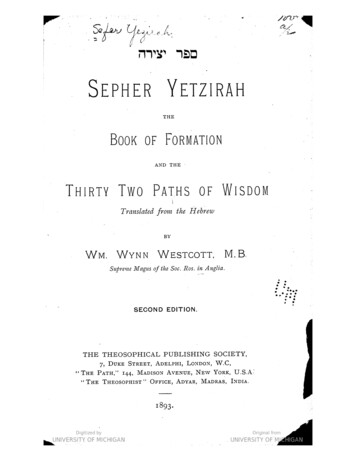
Transcription
r’.52510»‘ Sepher YetzBAN D THEThirty- Two Paths of Wisdom: Translated from the HebrewM.B‘ 15’HTS‘ ‘IanMI/gar?»-‘O’‘A‘ISEPHEII YETZIRAHirahook of FormationWm. Wynn Westcott,I'j'-‘.Supreme Magus of the Soc. Ros. in Anglia.SECON D ETHE7,'THEDITION .OSOPHICALDuke Street,The Path,"PUBAdelphi,144,LLISHIN G SOCIEondon,Madison Avenue,1893.TY,W.C,N ew York,USA- "The IONGenerated for John Patrick Deveney (University of Chicago) on 2015-01-07 23:48 GMT / c Domain in the United States / http://www.hathitrust.org/access use#pd-usAND THETIIIRTII TIIIIO'PATHST7/mzslated from theOFWISDOMebi/ewBYWIvI. WYNN WESTCOTT, MB.Supyenze Magus of the S05. Ros. in Anglia.SECOND EDITION.THE THEOSOPHICAL PUBLISHING SOCIETY,7, DUKE STREET, ADELPHI, LONDON, W.C,“THE PATH,” 144, MADISON AVENUE, NEVV'YORK, U.S.A5INDIA."THE THEosoPHIsI" OFFICE, ADYAR,MADRAS-,1893.
Generated for John Patrick Deveney (University of Chicago) on 2015-01-07 23:48 GMT / c Domain in the United States / http://www.hathitrust.org/access use#pd-usr
/" 4":PitCON TE‘"'(9 .\' 3 \l r',x“:5’.\N TS.4/’’,l""“ , cod”.-M/'.»—Preface to the Second EditionIntroductionThe Sepher YetzirahChapter I. Sephiroth,N umbers,H. The Twenty-Two LLettersettersIII. The Triad .IV. TheHeptad.Supplement .V. The DodecadVLSupplement .Conclusion .CONTENTS.The Thirty-Two Paths of Wisdom .N otes to the Sepher Yetzirah .T" ’Generated for John Patrick Deveney (University of Chicago) on 2015-01-07 23:48 GMT / c Domain in the United States / http://www.hathitrust.org/access use#pd-usN otes to the Thirty-Two Paths9WTI»-’‘IO“ "/Preface to the Second EditionIntroductionThe Sepher YetzirahChapter,,,,,,I. Sephiroth, Numbers, LettersII. The Twenty-Two LettersIII.- The TriadIV. The Heptad,,,,,,V.SupplementThe DodecadSupplementVI‘. ConclusionThe Thirty-Two Paths of WisdomNotes to the Sepher YetzirahNotes to the Thirty-Two Paths,,.,,,,so-4
PREFACETO THESECON D EDITION .It has been at the earnest wish of many students,members of the Theosophical Society,and of myHermetic fratres of the Order of the G.D.,made a revised translation of the "that I haveSepher Yetzirah."Inthis edition I have followed most closely the Hebrewversion of Joannes Stephanus Rittangelius,printed in 16of the L42 at Amsterdam,which wasand I have forsaken manyatinised renderings which had been adopted inthe First Edition,PREFACE TO THEfrom the works of Postellus andPistorius.The N otes have been exthey extended,plain and illustrate difficult passages,EDITION.and renderIT has been at the earnest’ wish of many students,members of the Theosophical Society, and of myHermetic fratres of the Order of the G.D.,that I have-made a revised translation of the “Sepher Yetzirah.” Inthis edition I have followed most closely the Hebrewversion of Joannes Stephanus Rittangelius, which wasprinted in 1642 at Amsterdam, and I have forsaken manyof the Latinised renderings which had been adopted inthe First Edition, from the Works of Postellus andthis abstruse treatise more comprehensible than it hasbeen hitherto found.F.T.S.Generated for John Patrick Deveney (University of Chicago) on 2015-01-07 23:48 GMT / c Domain in the United States / http://www.hathitrust.org/access use#pd-usW. W.W.,SECONDand it is hoped that.Pistorius.The Notes have been extended, and it is hoped thatthey explain and illustrate difficult passages, and renderthis abstruse treatise more comprehensible than it hasbeen hitherto found.VV. W. \V., F.T.S.
SEPHER YETZIRAH.IN TRODUCTION .The "Sepher Yetzirah,"or "Book of Formation,"isperhaps the oldest philosophical treatise which is yetextant in the Hebrew language. The great interestSEPHER YETZIRAH.which has been evinced of late years in the HebrewKabalah,to it,and the modes of thought and doctrine alliedhas induced me to translate this volume from theoriginal Hebrew texLts,and to collate with them theatin versions of mediaeval authorities. Three im-portant books of the "Zohar,is the great storehouse of K"for the first time translated into Eand erudite Kabalist,Mac Gregor Mathers,ESplendour,"whichand the "nglish by that skilfulSepher Yetzirah ".jINTRODUCTION.have beenmy fellow student in occult science,in annglish translation is almost a necessary companion tothese even more abstruse disqindeed mutually exThe "Sepher YetzThe Buisitions: the two booksplain each other.irah"ook of Formation,although this name means"is not in any sense a narra-Generated for John Patrick Deveney (University of Chicago) on 2015-01-07 23:48 GMT / c Domain in the United States / http://www.hathitrust.org/access use#pd-us"or "abalistic teaching,tive of Creation,or a substitute Genesis,but it is a veryancient and instructive philosophical treatise upon oneaspect of the origin of the universe and mankind;anaspect at once archaic and essentially Hebrew. Thegrouping of the processes of origin into an arrangement,at once alphabetic and numeral,is one only to be foundin Semitic authors.Attention must be called to the essential peculiarity ofHebrew doctrines,the inextricable and necessary associa-“Sepher Yetzirah,” or “Book of Formation,” isperhaps the oldest philosophical treatise which is yetThe great interestextant in the Hebrew language.THEwhich has been evinced of late years in the HebrewKabalah, and the modes of thought and doctrine alliedto it, has induced me to translate this volume from theoriginal Hebrew texts, and to collate with them theLatin versions of mediaeval authorities. Three important books of the “ Zohar,” or “Splendour,” whichis the great storehouse of Kabalistic teaching, have beenfor the first time translated into English by that skilfuland erudite Kabalist, my fellow student in occult science,Mac Gregor Mathers, and the “ Sepher Yetzirah in anEnglish translation is almost a necessary companion tothese even more abstruse disquisitions: the two booksindeed mutually explain each other.The “Sepher Yetzirah although this name means“ The Book ofFormation,” is not in any sense a narrative of Creation, or a substitute Genesis, but it is a veryancient and instructive philosophical treatise upon oneaspect of the origin of the universe and mankind; anaspect at once archaic and essentially Hebrew. Thegrouping of the processes of origin into an arrangement,at once alphabetic and numeral, is one only to be foundin Semitic authors,Attention must be called to the essential peculiarity ofHebrew doctrines, the inextricable and necessary associa”'”A
5tion of numbers and letters;'number,signification,The Kevery letter suggesting aand every group of letters having a numericalas vital as its literal meaning.abalistic principles involved in the reversal ofHebrew letters,and their substitution by others,definite schemes,onshould also be studied and borne inmind.It is exactly on these principles that the "idea"of this disquisition rests;groundworkand these principlestion of numbers and letters; every letter suggesting a‘number, and every group of letters having a numericalsignification, as vit al as its literal meaning.The Kabalistic principles involved in the reversal ofHebrew letters, and their substitution by others, ondefinite schemes, should also be studied and borne inmind.It is exactlyon these principles that the “ groundworkidea” of this disquisition rests; and these principlesmay be traced throughout the Kabalistic volumes whichhave succeeded it in point of time, and development,'and which are now associated together in one volumeand known as the Zohar,” or “ Book of Splendour,” acollection of treaties which is in the main concernedwith the essential dignities of the God-head, and withthe emanations which have sprung therefrom, with thedoctrine of the Sephiruth,and theideals of Macroprosopusand Microprosopus.The “ Sepher Yetzirah,” on the other hand is mainlyconcerned with our universe and with the Microcosm.The opinions of Hebrew Kabalistic Rabbis and oftwo French mystics may be fitly introduced here.The following interesting comment is from RabbiMoses Botarel :——“ It was Abraham our Father—blessedbe he—who wrote this book to condemn the doctrine ofthe sages of his time, who were incredulous of thesupreme dogma of the Unity. At least, this was theopinion of Rabbi Saadiah———blessed be he——— as writtenin the first chapter of his book ‘The Philosopher’sStone.’ These are his words: The sages of ‘Babylonattacked Abraham on account of his faith ; for they wereall against him although themselves separable into threesects. The First thought that the Universe was subjectto the control of two opposing forces, the one existingbut to destroy the other, this is dualism ; they held thatthere was nothing in common between the author ofevil and the author of good. The Second sect admittedThree great Powers; two of them as in the first case,‘and a third Power whose function was to decide betweenimay be traced throughout the Kabalistic volumes whichhave succeeded it in point of time,and development,and which are now associated together in one volumeand known as the "Zohar,"or "Book of Splendour,"acollection of treaties which is in the main concernedwith the essential dignities of the God-head,and withthe emanations which have sprung therefrom,doctrine of the Sephiruth,with theand the ideals of Macroprosopusand Microprosopus.The "“Sepher Yetzirah,"on the other hand is mainlyGenerated for John Patrick Deveney (University of Chicago) on 2015-01-07 23:48 GMT / c Domain in the United States / http://www.hathitrust.org/access use#pd-usconcerned with our universe and with the Microcosm.The opinions of Hebrew Kabalistic Rabbis and oftwo French mystics may be fitly introduced here.The following interesting comment is from RabbiMoses Bbe heotarel:"It was Abraham our Fatherthe sages of his time,-who were incredulous of thesupreme dogma of the Unity. At least,opinion of Rabbi Saadiahthis was theblessed be hein the first chapter of his book 6Stone.'blessedwho wrote this book to condemn the doctrine ofas writtenThe Philosopher'attacked Abraham on account of his faith;s‘These are his words: The sages of Babylonfor they wereall against him although themselves separable into threesects. The First thought that the Universe was subjectto the control of two opposing forces,istingbut to destroy the other,the one exthis is dualism;they held thatthere was nothing in common between the author ofevil and the author of good. The Second sect admittedThree great Powers;two of them as in the first case,and a third Power whose function was to decide between i
7the two others,7rthe two others,a supreme arbitrator. The Third sectrecognised no god beside the Sun,the sole principle of exRabbi Judah Ha Lthis treatise,the exin which it recognisedistence."evi,in his critical description ofwrote: "The Sepher Yetzirah teaches usistence of a Single Divine Power by shewing usthat in the bosom of variety and multiplicity,Unity and Harmony,there is ,aand that such universal concordcould only arise from the rule of a Supreme Unity."EJiphas Lof the "p. 54: 'Jezevi,the famous French Occultist,Sepher Yetz6The Zirah,"in his "thus wroteHistoire de la Magie,ohar is a Genesis of illumination,the Sepherirah is a ladder formed of truths. Therein are ex“-plained the thirty-two absolute signs of sounds,numbers and letters: each letter reproduces a number,idea and a form;anso that mathematics are capable of ap-plication to ideas and to forms not less rigorously thanby exact proportion and perfectGenerated for John Patrick Deveney (University of Chicago) on 2015-01-07 23:48 GMT / c Domain in the United States / http://www.hathitrust.org/access use#pd-usto numbers,correspondence. By the science of the Sepher Jezthe human spirit is fixed to truth,irahand in reason,and isable to take account of the possible development ofintelligence by the evolutions of numbers. The Zrepresents absolute truth,oharand the Sepher Jezprovides the means by which we may seize,irahappropriateand make use of it."Upon another page ESepher Jezliphas LTheirah and the Apocalypse are the master-pieces of Occultism;than words;they contain more wisdomtheir expression is as figurative as poetry,and at the same time it is as exIn the volume entitled "LaKFrench scholar and Membre de LFranck,evi writes: "act as mathematics."abbale"'there is a chapter on the "by the eminentInstitut,AdolpheSepher YetzThe Book of Formation contains,a system of physics,I will not saybut of cosmology such as couldbe conceived at an age and in a country where the habitof explaining all phenomena by the immediate action ofthe First Cause,numbers, byproportionperfectcorrespondence. By the scien ce of the Sepher Jezirahthe human spirit is fixed to truth, and in reason, and isable to take account of the possible development ofintelligence by the evolutions of "numbers. The Zoharrepresents absolute truth, and the Sepher Jezirahprovides the means by which We may seize, appropriatetoexactandand make use of it.”Upon another page Eliphas Lévi Writes 2 “ TheSepher Jezirah and the Apocalypse are the masterpieces of Occultism ; they contain more wisdomthan words ; their expression is as figurative as poetry,and at the same time it is as exact as mathematics.”In the volume entitled “ La Kabbale” by the eminentFrench scholar and Membre de L’Institut, AdolpheFranck, there is a chapter on the “ Sepher Yetzirah.”He Writes as follows :—“The Book of Formation contains, I will not saya system of physics, but of cosmology such as couldbe conceived at an age and in a country Where the habitof" explaining all phenomena by the immediate action ofthe First Cause, tended to check the spirit of observa-irah."He writes as follows :""supreme arbitrator. The Third sectrecognised no god beside the Sun, in which it recognisedthe sole principle of existence.”Rabbi Judah Ha Levi, in his critical description ofthis treatise, Wrote: “The Sepher Yetzirah teaches usthe existence of a Single Divine Power by shewing usthat in the bosom of variety and multiplicity, there is ,aUnity and Harmony, and that such universal concordcould only arise from the rule of a Supreme Unity.”Eliphas Lévi, the famous French Occultist, thus Wroteof the ‘.‘ Sepher Yetzirah,” in his Histoire de la Magie,”p. 54: “ The Zohar is a Genesis of illumination,the SepherJezirah is a ladder formed of truths. Therein are explained the thirty-two absolute signs of sounds,numbers and letters 2 each letter reproduces a number, anidea and a form; so that mathematicsare capable of application to ideas and to forms not less rigorously thanatended to check the spirit of observa-V'yd-‘;»
8tion,and where in consequence certain general andsuperficial relations perceived in the natural worldpassed for the science of N ature."is simple and grave;."Its formthere is nothing like a demonstra-tion, and where in consequence certain generalandsuperficial relations perceived in the natural World»“Its formpassed for the science of Nature.”is simple and grave ; there is nothing like a demonstration nor an argument ; but it consists rather of a seriesof aphorisms, regularly grouped, and which have all theconciseness of the most ancient oracles.”In his analysis of the “ Sepher Yetzirah,” he adds 2“ TheBook of Formation, even if it be not very voluminous, and if it do not altogether raise us to veryelevated regions of thought, yet offers us at least acomposition which is very homogeneous and of a rareoriginality. The clouds which the imagination ofcommentators have gathered around it, will be dissipated, if we look for, in it, not mysteries of ineffablewisdom, but an attempt at a reasonable doctrine, madewhen reason arose-, an effort to grasp the plan of theuniverse, and to secure the link which binds to onecommon principle, all the elements which are aroundus.”“The last word of this system is the substitution ofthe absolute’ divine Unity for every idea of Dualism,for that pagan philosophy which saw in matter aneternal substance Whose laws were not in accord withDivine \/Vill; and for theBiblical doctrine, which by its ideaof Creation, postulates two things, the Universe andGod, as two substances. absolutely distinct one from theother.”In fact, in the ‘ Sepher Yetzirah,’ God considered asthe Infinite and consequently the indefinable Being,extended throughout all things by his power andexistence, is While above,‘ yet not outside of numbers,sounds’ and letters,—the principles and general lawswhich we recognise.”“Every element has‘ its source from a higher form,and all things have their common origin from the WordSo God is at once, in(Logos), the Holy Spirit.the highest sense, both the matter and the form of theuniverse. Yet He is not only that form; for nothing can.tion nor an argument;of aphorisms,but it consists rather of a seriesregularly grouped,and which have all theconciseness of the most ancient oracles."In his analysis of the ""The BSepher Yetzook of Formation,minous,irah,"he adds :even if it be not very volu-and if it do not altogether raise us to veryelevated regions of thought,yet offers us at least acomposition which is very homogeneous and of a rareoriginality. The clouds which the imagination ofcommentators have gathered around it,pated,if we look for,wisdom,in it,will be dissi-not mysteries of ineffablebut an attempt at a reasonable doctrine,when reason arose,universe,madean effort to grasp the plan of theand to secure the link which binds to onecommon principle,all the elements which are around"Generated for John Patrick Deveney (University of Chicago) on 2015-01-07 23:48 GMT / c Domain in the United States / http://www.hathitrust.org/access use#pd-usus."The last word of this system is the substitution ofthe absolute divine Unity for every idea of Dualism,for that pagan philosophy which saw in matter aneternal substance whose laws were not in accord withDivine Will;and for the Bof Creation,postulates two things,God,which by its ideathe Universe andas two substances absolutely distinct one from theother.""iblical doctrine,In fact,in the 'Sepher Yetzthe Infinite and conseqirah,'God considered asuently the indefinable Bextended throughout all things by his power andexistence,is while above,sounds and letters,eing,yet not outside of numbers,the principles and general lawswhich we recognise.""Every element has its source from a higher form,and all things have their common origin from the Word(Logos),the Holy Spirit. . . So God is at once,the highest sense,inboth the matter and the form of theuniverse. Yet He is not only that form;for nothing can’“.
99or does exist outside of Himself;foundation of all,are symbols of His intelligence."Hebrew tradition assigns the doctrines of the oldestportions of the "Zohar"to a date antecedent to thebuilding of the Second Temple,Jochai,a.d. 70-80,ara,mperor Titus,is considered to have been the first to committhese to writing,laxbut Rabbi Simeon benwho lived in the reign of the Eand Rabbi Moses de Lin Spain,and published the "eon,who died in 1305,Zof Gauda-certainly reproducedohar."Ginsburg,speaking of the ZAin Suph,says that they were unknown until the 13thcentury,oharic doctrines of thebut he does not deny the great antiqdoes exist outside of Himself; His substance is thefoundation of all, and all things bear His imprint andare symbols of His intelligence.”Hebrew tradition assigns the doctrines of the oldestportions of the “ Zohar” to a date antecedent to thebuilding of the Second Temple, but Rabbi Simeon benJochai, who lived in the reign of the Emperor Titus,A.D. 7o—8o, is considered to have been the first to committhese to writing, and Rabbi Moses de Leon, of Gaudalaxara, in Spain, who died in 1305, certainly reproducedand published the Zohar.”Ginsburg, speaking of the Zoharic doctrines of theAin Suph, says that they were unknown until the 13thcentury, but he does not deny the great antiquity ofthe Sepher Yetzirah, in which it will be noticed the“ AinSuph Aur and Ain Suph are not mentioned.I suggest, however, that this omission is no proof thatthe doctrines of “Ain Suph Aur” and “Ain Suph”did not then exist, becauseit is a reasonable supposition,that the Sepher Yetzirah was the volume assignedto the Yetziratic VVorld, the third of the fourKabalistic Worlds of Emanation, while the “ AschMetzareph” is concerned with the Assiatic, fourth, orlowest VVorld of Shells, and is on the face of it analchemical treatise; and again the Siphra Dtzenioutha may be fittingly considered to be an Aziluthicwork, treating of the Emanations of Deity alone; andthere was doubtless a fourth work assigned to the Worldof Briah——the second type, but I have not been able toidentify this treatise.Both the Babylonian and the Jerusalem Talmudsrefer to the Sepher Yetzirah.” Their treatise namedSanhedrin,” certainly mentions the “Book of Formation,” and another similar Work; and Rashi in hiscommentary on the treatise “ Erubin,” considers this areliable historical notice. This work then, or a similarpredecessor, is at least as old as A.D. 2oo.Other positive historical notices are those of SaadjahGaon, who died A.D. 940, and Judah Halevi, A.D. 1150;orHis substance is theand all things bear His imprint anduity of“the Sepher Yetzirah,44 Ain Suph Aur "I suggest,in which it will be noticed theand "however,Ain Suph "that this omission is no proof thatthe doctrines of 44 Ain Suph Aur"ist,that the 44 Sepher Yetzto the YetzKareph"alchemical treatise;work,Ain Suph"was the volume assignedthe third of the fourmanation,”while the "is concerned with the Assiatic,lowest World of Shells,outha "irah "iratic World,abalistic Worlds of EMetzand "because it is a reasonable supposition,Generated for John Patrick Deveney (University of Chicago) on 2015-01-07 23:48 GMT / c Domain in the United States / http://www.hathitrust.org/access use#pd-usdid not then exare not mentioned.Aschfourth,orand is on the face of it anand again the 44 Siphra Dtzmay be fittingly considered to be an Aztreating of the Eeni-iluthicmanations of Deity alone;andthere was doubtless a fourth work assigned to the Worldof Briahthe second type,but I have not been able toidentify this treatise.Both the Babylonian and the Jerusalem Talmudsrefer to the 44 Sepher Yetz44 Sanhedrin,ation,""irah."Their treatise namedcertainly mentions the 44 Band another similar work;commentary on the treatise 44 Erubin,reliable historical notice. This work then,predecessor,"considers this aor a similaris at least as old as a.d. 200.who died a.d. 940,”““”Other positive historical notices are those of SaadjGaon,ook of Form-and Rashi in hisand Judah Halevi,aha.d. 1150;”“““
IO10both these Hebrew classics speak of it as a very ancientwork.The most generally accepted modern opinion is thatthe author was Rabbi Akiba,the Emperor Hadrian,Graetz,who lived in the time ofa.d. 120.however,assigns it to early Gnostic times,both these Hebrew classics speak of it as a very ancientwork.The most generally accepted modern opinion is thatthe author was Rabbi Akiba, who lived in the time ofthe Emperor Hadrian, A.D. 120.Graetz, however, assigns it to early Gnostic times,third or fourth century, and Zunz speaks of it as postTalmudical, and belonging to the Geonic period 700 to8oo A.D. ; Rubinsohn, in the Bibliotheca Sacra,”speaks of this latter idea as having no real basis.The Talmuds were first collected into a concretewhole, and printed in Venice, I520 A.D.The “Zohar was first printed in Mantua in I558,again in Cremona, 1560, and at Lublin, 1623, and a fourthedition by Knorr von Rosenroth, at Sulzbach in I684.Some parts are not very ancient, since some versionsmention the Crusades.Six extant Hebrew editions of the “ Sepher Yetzirah”Thewere collected and printed at Lemberg in 1680.oldest of these six recensions was that of SaadjahGaon.Commentaries by judah Halevi, and by Eben Ezra,of the 12th century, are also known.There are now to be found in the best libraries,several Latin versions, viz., thatof Gulielmus Postellus,I 552, Paris; one by Johann Pistorius, in his “ArtisCabalisticae Tomus,” I 587, Basle ; and a third bythird or fourth century,Talmudical,800 a.d.;and Zunzspeaks of it as postand belonging to the Geonic period 700 toRubinsohn,in the "Bibliotheca Sacra,"speaks of this latter idea as having no real basis.The Talmuds were first collected into a concretewhole,The "and printed in VZohar "“1520 a.d.was first printed in Mantua in 1558,again in Cremona,edition by Kenice,1560,and at Lnorr von Rosenroth,ublin,at SulzSome parts are not very ancient,1623,bach in 16and a fourth84.since some versions”mention the Crusades.Sixextant Hebrew editions of the "oldest of these sixGaon.emberg in 16Generated for John Patrick Deveney (University of Chicago) on 2015-01-07 23:48 GMT / c Domain in the United States / http://www.hathitrust.org/access use#pd-uswere collected and printed at LSepher Yetz80. Therecensions was that of SaadjCommentaries by Judah Halevi,of the 12th century,and by Eirah"ahben Ezra,are also known.There are now to be found in the best libraries,several L1552,atin versions,Paris ;viz.,that of Gulielmus Postellus,one by Johann Pistorius,Cabalisticse Tomus,"1587,Joannes Stephanus Rittangelius,Basle;16this latter gives both Hebrew and L42,atin,in his "Artisand a third byAmsterdam;and also theThirty-Two Paths as a supplement.There is also a good German translation,Friedrich von Meyer,by Johanndated 1830. Q uite recently,since the completion of my translation,been drawn to a version by Isidor Kalisch,in which hehas reproduced many of the valuable annotations ofMeyer. The edition which I now offer is fundamentallythat of the ancient Hebrew codices translated intoEnglish,Pistorius,and collated with the LPostellus,atin versions ofand Rittangelius.andmy attention hasJoannes Stephanus Rittangelius, 1642, Amsterdam;this latter gives both Hebrew and Latin, and also theThirty-Two Paths as a supplement.There is also a good German translation, by JohannFriedrich Von Meyer, dated 1830. Quite recently, andsince the completion of my translation, my attention hasbeen drawn to a version by Isidor Kalisch, in which hehas reproduced many of the valuable annotations ofMeyer. The edition which I now offer is fundamentallythat of the ancient Hebrew codices translated intoEnglish, and collated with the Latin versions ofPistorius, Postellus, and Rittangelius.
IIIIThe following copies of the "Hebrew,1. A VI have also exersion by Saadiah,others,Mantua,2. A V3. A V4. A VAmsterdam,9. ,1713,ersion,5.8.ab. ben David,1562,1642,Z.,,,and three,,,,,,1719,8vo.4to.by Moses ben vo.10. A MSS. copy dated 1719,A Version with the commentary of Rabbi AbrahamF. Dior, Amsterdam, 164.2, 4.to.AVersion with preface by M. benChagiz,U.)Amsterdam, 1713, 16mo.A Version, Constantinople, I719, 8vo.Zolkiew, 1745, 4to.,,,,by Moses ben Jacob, Zozec, I779, 4to.,,,,2.1745,Dyhernfurth,,,mo.Grodno,in the BI add here the full titles of the three L4to.8KO\I‘uU1- 5.ritish Museum.atin versions;A.they are all to be found in the B"Abrahami Patriarchae Liber JezPatribus qpositus Isaaco,conservatus,ibrary.irah sive Forma-uidem Abrahami temporapraecedentibus revelatus,exritish Museum LGenerated for John Patrick Deveney (University of Chicago) on 2015-01-07 23:48 GMT / c Domain in the United States / http://www.hathitrust.org/access use#pd-ustionis Mundi,sed ab ipso etiam Abrahamoet per prophetarum manus posteritatisecundo divinae veritatis loco,hoc est in ratione qhabitus."Parisiis,uce est1552. GulielmusPostellus."Id est Ladscribitur,iber Jezirah,qui Abrahamos,Patriarchaeunacum Commentario Rabi Abraham F.D.super 32 semitis Sapientiae,aquibus Liber Jezirahincipit: Translatus et notis illustratus a JoanneStephano Rittangelio LRegiomontana Prof. EIn Tomus Primus of "ing. Orient,xtraord,in E"lect. Acad.Amstelodami,1642.Artis Cabalisticae hoc estreconditae theologiae et philosophise script orum."Basileae 1587,is found "Hebraice Sepher Jezira ;sive filiis ore traditus. Hinc jLiber de Creatione Cabalistinis,Authore Abrahamo. Succes-am rebus Israel inclinatisne deficeret per sapientes Hierusalem arcanis et.,,,,.,,,,.,,,,Grodno, I806, 4to.Dyhernfurth, I812, 8vo.Salonica, I831, 8vo.'A MSS. copy dated 1719, in the British Museum.I add here the full titles of the three Latin Versions;they are all to be found in the British Museum Library.“ Abrahami PatriarchmLiber" jezirah sive Formationis Mundi, Patribus quidem Abrahami temporapraecedentibus revelatus, sed ab ipso etiam Abrahamoexpositus Isaaco, et per prophetarum manus posteritaticonservatus, ipsis autem 72. Moses auditoribus insecundo divinae veritatis loco, hoc est in ratione quoe estposterior authoritate,habitus.” Parisiis, I 552. GulielmusPostellus.“Id est Liber Jezirah, qui Abrahamos, Patriarchaeadscribitur, unacum Commentario Rabi Abraham F.D.super 32 semitis Sapientiae, a quibus Liber Jezirahincipit: Translatus et notis illustratus a JoanneStephano Rittangelio Ling. Orient. in Elect. Acad.Arnstelodami, 164.2.Regiomontana Prof. Extraord,”“In Tomus Primus ofArtis Cabalisticae hoc estreconditae theologiae et philosophiae scriptorum.”Basileae 1587, is found “ Liber de Creatione Cabalistinis,Hebraice Sepher ]ezira ; Authore Abrahamo. Successive filiis ore traditus. Hinc jam rebus Israel inclinatisne deficeret per sapientes Hierusalem arcanis et.ipsis autem 72. Moses auditoribus inposterior authoritate,”others, Mantua, I 562, 4to.4to.Constantinople,olkiew,,,i6following copiesof the “Sepher Yetzirah inIHebrew, ha
THE “Sepher Yetzirah,” or “Book of Formation,”is perhaps the oldest philosophicaltreatise which is yet extant in the Hebrew language. which has been evinced of late years in the Hebrew Kabalah, and the modes of thought and doctrine allied to it, has induced me to translate thisvolum



